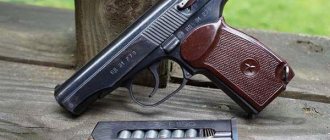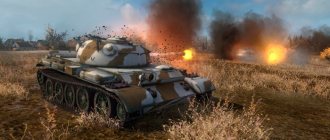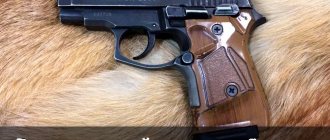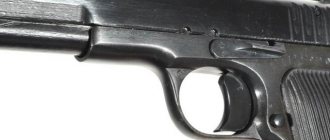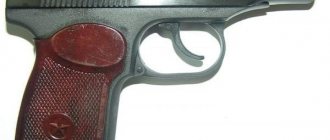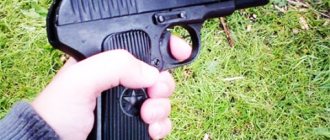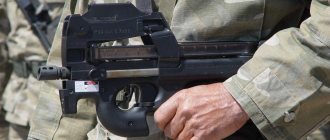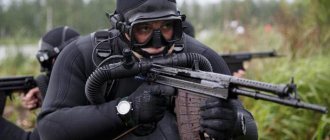The best pistols in Russia
The Makarov pistol
Makarov pistol with magazine and cartridges (9×18 mm PM)
After the Great Patriotic War, the USSR began not only to create nuclear weapons, but also to develop new, more advanced pistols designed to replace the conquered TT model 1933 and the Nagant revolver. The designers simultaneously worked on two weapon options:
- A more compact one, which fires only single shots, serves as a means of self-defense for military personnel who are not entitled to a carbine or machine gun. And for law enforcement officers who value the concealed carry option;
- With a longer barrel that fires both single shots and bursts, it is intended for firing during combat and for special forces operations.
The first pistol was developed on the basis of the German Walther PP, which first appeared in 1929. Initially, models were designed in two calibers - 7.65 mm and 9 mm. As a result, Nikolai Fedorovich Makarov, the “father” of the now famous, also created his own 9x18 mm PM cartridge, which turned out to be more powerful than Walter’s 9x17. This cartridge and caliber was preferred. The pistol won the competition in 1948, and three years later it entered service with law enforcement agencies.
Based on Walter, Makarov managed to create a weapon of a simpler design by reducing the number of parts, by combining their functions, while simultaneously increasing their strength and practically eliminating the charge sticking into the chamber bevel, which causes firing delays. The pistol is characterized by a very high range for a compact weapon (effective - 50 meters) and combat accuracy. The magazine holds 8 rounds.
Even today the PM is the best Russian pistol remaining in the arsenal of Russian law enforcement agencies.
Stechkin automatic pistol
The Stechkin pistol with an APS holster-butt
was the second pistol to win a competition to arm combat officers, as well as soldiers of a number of special forces, and entered service in 1951. Later, due to the disadvantages that emerged during use, it was discontinued, but after the collapse of the USSR it was again in demand as a means of combating terrorism and organized crime. In the same “dashing nineties”, under the leadership of Igor Yakovlevich Stechkin, improved modifications were developed:
- OTs-23 “Dart”;
- OTs-27 "Berdysh";
- OTs-33 "Pernach".
The disadvantages of the Stechkin automatic pistol were considered to be excessive bulkiness, in particular in combination with a holster-butt, and insufficient power due to an unsuccessful choice of cartridge. The 9x18 mm PM, ideal for the “native” Makarov, gives an effective range (no more than 100 m) and penetration that are too short for APS.
The important advantages of the APS are low recoil and minimal toss when fired, allowing you to shoot as quickly and accurately as possible, which is very good in close combat. These advantages of Stechkin’s brainchild, combined with impeccable reliability and excellent accuracy, allow us to include it in the list of the best domestic pistols.
Today, Russian pilots performing combat missions in Syria are armed with 20-round APS as a personal weapon.
Pistol Tula Tokarev (TT)
This is what a genuine wartime TT looks like
- the most legendary of the pistols of the USSR and Russia, created in 1930, went through the war, was used after it, and has not lost its popularity to this day. Sports and signal modifications of TTs, pneumatic guns and trauma guns, sold under various brands, are produced and are in demand.
Designed by Fedor Vasilyevich Tokarev on the basis of the 1903 Browning chambered for the 7.63x25 mm Mauser cartridge, it is ultimately loaded with eight 7.62x25 mm TT ammunition. The effective range is not inferior to the PM (50 m). Due to the length of 195 mm, it is completely suitable for concealed carry. It is distinguished by a number of design features, the most notable being the absence of a safety lock, replaced by a safety cocking mechanism. Has high power and accuracy.
Pistol GSh-18
The GSh-18 is used as a service and award weapon.
Created in modern Russia, it has been in operation since 2001. The letters in the name are due to the designers V.P. Gryazev. and Shipunov A.G., and the numbers indicate the capacity of the store.
Currently listed on the list of award weapons. It is in service with the following domestic departments:
- Ministry of Justice;
- FSSP;
- Ministry of Defense (along with PM);
- Prosecutor's Office (along with Beretta 92);
- Ministry of Internal Affairs (as a weapon for a number of categories of workers and partly special forces).
The 9x19 mm 7N31 armor-piercing cartridge was specially created for the Gryazev-Shipunov, but other ammunition is also suitable for the pistol, including 9x19 Parabellum and 9x19 NATO.
The length of the pistol is only 183 mm. The effective range is 50 m. It features the option of equipping the barrel with luminous capsules for firing in poor visibility. Quite comfortable for the shooter due to its low weight (up to 800 grams with a full magazine), well-thought-out handle shape and partial recoil damping.
Gyurza pistol
The “Gyurza” (SPS, SR-1) pistol magazine holds 18 high-performance 9x21 mm cartridges.
“Gyurza” is the name given to Serdyukov’s self-loading pistol, known as SPS and under the designation SR-1. The Gyurza was created at TsNIITOCHMASH to arm special forces. Prepared since 1996.
It was designed for the high efficiency 9x21 mm cartridge, developed at the same institution. It is characterized by an increased effective range (100 m), the ability to destroy living targets in armored vehicles, as well as unarmored vehicles. Holds 18 ammunition, weighing 1110 g together with them.
The Makarov pistol is one of the best pistols of the 20th century
The Makarov pistol is rightly called the “Kalashnikov” of pistols. This automatic 9mm pistol was designed in 1948 by Nikolai Makarov. Due to the simplicity of its design, the reliability of the proposed design and ease of use, the PM remained in production for more than half a century. More than 2 million copies of this pistol were produced in the Soviet Union alone. It was only in the mid-1990s that the Makarov pistol was replaced by the new Yarygin pistol (YA), which was adopted as a standard weapon for law enforcement agencies. This year, the famous Russian gunsmith Nikolai Makarov would have turned 100 years old. As is often the case with good inventions, they outlive their creators. The Makarov pistol has been in service with Russian security forces for more than 60 years. At the moment, the PM can safely be considered one of the most famous small arms on the planet. The Makarov pistol, which became the designer’s first and last development in the field of creating pistols, is today known in many countries as a very simple and reliable melee weapon.
Ask any person in Russia, even one not versed in military affairs: what is the most famous domestically produced pistol? Most people, without hesitation, will name the Makarov pistol. This pistol became a generalization of all the experience accumulated by our country during the Great Patriotic War, notes Mikhail Dragunov, the son of the famous Russian gunsmith who created the famous SVD.
According to Mikhail Dragunov, for its time, the Makarov pistol absorbed all the best achievements in the field of pistol technology. As a result, a modern combat pistol was adopted by the Soviet Army. Judging by the fact that this model has not left the stage of the world pistol market for more than 60 years, we can admit that the design of the model was extremely successful. According to him, Nikolai Makarov managed to design a pistol with a wide range of possible uses. The Makarov pistol was used both as a status weapon for a Soviet officer, and as a weapon for law enforcement officers, and as a weapon for special units, a concealed carry weapon.
A competition for the development of a new pistol, designed to replace the 7.62 mm TT pistol of the 1933 model, was announced in the Soviet Union in 1945. According to the terms of the competition, the new pistol had to surpass the TT in reliability and weight and size characteristics. It had to have a caliber of 9 or 7.65 mm, have a good stopping effect of the bullet and no less destructive force than its predecessor pistol.
The winner of the competition was a pistol designed by a team led by Nikolai Fedorovich Makarov (years of life: 1914-1988). At the same time, the pistol proposed by Makarov won a competition from the leading Soviet rifle design bureaus - Simonov and Tokarev. The preliminary design was completed in 1947, and in 1948 the final version of the new pistol was ready. Its production was established in Izhevsk in 1949, then it was produced here for more than 50 years. The 9-mm Makarov pistol, or PM, was officially adopted into service by the Soviet Army, state security agencies and the Ministry of Internal Affairs in 1951. Full-fledged mass production of the pistol began in 1952 at the Izhevsk Mechanical Plant.
The PM was built on a design that was also used in the German Walther PP (Walther Polizei Pistole). Its automation operated based on the recoil of the free shutter - the simplest and most reliable solution. At the same time, there were restrictions on the power of the cartridge used. The return spring of the bolt was placed directly on the barrel of the pistol; in the rear part of the bolt casing there was a notch on both sides for reloading the pistol manually. The pistol was equipped with a double-action trigger mechanism (self-cocking). It also received an open trigger, which made it possible to remove the main gun from the safety, cock the hammer and open fire using only one hand. At the same time, the design of the pistol consisted of only 25 parts, which greatly simplified the process of maintenance and repair, and also increased its reliability.
The designer himself explained his success in creating the PM by the colossal work that was invested in its development. Makarov worked every day, almost without days off, sometimes he worked from 8 o'clock in the morning until 2-3 o'clock in the morning. As a result, he was able to modify and shoot 2-3 times more samples than his competitors. This, of course, made it possible to perfect the survivability and reliability of the pistol. A clear confirmation of this is the fact that, at least until 2004, the security of the State Unitary Enterprise “Instrument Design Bureau” included a serviceable model of a Makarov pistol produced in 1949 (serial model number - 11), the firing rate of this “barrel” was about 50 thousand shots .
In the world, PM was often called the “Russian Walter”. Some even believed that this was a hint that Soviet developers borrowed the idea for this pistol from their German colleagues in 1945, when Soviet troops took control of the city where this enterprise was located. However, the very consistency of this version is called into question by the fact that initially the American army entered Zella-Melis, which as a result received the most valuable documentation.
The Makarov pistol, like any pistol of those years, had analogues. At the moment when it was put into service, tests were also carried out on its competitors, including foreign self-loading pistols Walther PP and Walther PPK; these pistols were among the first mass-produced samples with a double-action trigger mechanism. “Sometimes they say that the PM was completely copied from the German Walter, but the only thing that passed on to it from the German model was the principle of disassembly. The principle of automation and the circuit itself existed before this, but the firing mechanism in the PM was an original development. The gun was convenient and simple, consisting of less than 30 parts,” emphasized Mikhail Degtyarev.
In any case, the nickname “Russian Walter” is, of course, an excellent compliment, since at all times Walter was considered one of the undisputed leaders in the pistol market. Domestic development was in no way inferior to it. As a result, the PM was recognized as one of the best examples of close combat small arms of the twentieth century, along with the German Walter, as well as Browning, Beretta and Astra Constable. Like the Kalashnikov assault rifle, the Makarov pistol has become a legendary weapon around the world.
When firing at short distances, according to experts, the PM was simply irreplaceable. Thanks to the use of a new, shorter cartridge and simpler operation of the automation system, the Makarov pistol was very much ahead of its predecessors in terms of reliability and maneuverability. At the same time, the power of its cartridge was second only to the TT; at the same time, the PM had a larger caliber (9 mm instead of 7.62 mm), which made it possible to maintain the stopping effect of the bullet at the same level. For a compact pistol it had excellent accuracy. When using standard 57-N-181 cartridges, the dispersion radius at 50 meters was 160 mm, at 25 meters - 75 mm, at 10 meters - only 35 mm.
One of the undoubted advantages of the pistol was its light weight. The PM was 130 grams lighter than the TT pistol (0.81 kg with a full magazine and 0.73 kg unloaded). It was also distinguished by its constant readiness for action - the pistol could be brought into firing position almost instantly. Also, some experts argue that the PM can be safely carried with the safety lever removed and with a cartridge in the barrel - that’s how safe it is. The straight pistol grip allows you to intuitively shoot at a chest target from a distance of up to 15 meters, guaranteeing its confident defeat. And at closer distances, you don’t even have to raise the gun at all - all the bullets can be placed at the target from the hip.
Since the start of mass production in the country, a huge number of modifications of the PM have been created - combat, sports, service, civilian, as well as gas pistols. At the same time, the Makarov pistol was produced not only in the Soviet Union, but abroad. For example, in the GDR it was called Pistole M. The PM was also produced in China, the Czech Republic, Bulgaria, and Yugoslavia.
The pistol is still in strong demand on the market, including in the United States. Most often in America it is used as an effective weapon of self-defense. The pistol has very good dimensions: length - 161 mm, height - 127 mm, barrel length - 93.5 mm. In addition, it compares favorably with its competitors due to its low price and reliability. It is interesting to note that in Finland, the Makarov pistol, along with the Glock 17, CZ-85 and Beretta 92F pistols, is one of the four pistols that are required to be mastered in practical shooting courses. In addition, the PM became the first small arms weapon in history to fly into space. The pistol was included in the set of property and equipment of the Soviet cosmonauts on the Vostok spacecraft.
Currently, serial production of the Makarov pistol and some of its modifications is still ongoing. Despite the fact that in Russian law enforcement agencies and the army the PM is gradually being replaced by the Yarygin pistol and other new models of small arms, the Makarov pistol remains in service to this day, continuing to be one of the most popular and sought-after models of Russian-made short-barreled small arms.
Tactical and technical characteristics of the PM: Cartridge - 9x18 mm. Weight with loaded magazine - 0.81 kg, weight without cartridges - 0.73 kg. Length - 161 mm, width - 30.5 mm, height - 126.75 mm. Barrel length - 93 mm. Box magazine, 8 rounds. Sighting range - 50 m. Rate of fire - up to 30 rounds/min. The initial speed of the bullet is 315 m/s.
Sources of information: https://rostec.ru/news/4514573 https://ria.ru/defense_safety/20140522/1008800227.html https://lenta.ru/lib/14162215
Best US pistols
Smith & Wesson M&P9
The Smith & Wesson M&P9 features a comfortable grip and minimal barrel lift.
The M&P in the name of the brand of pistol manufactured by Smith & Wesson Firearms Co. since 2005, stands for Military and Police. Nevertheless, weapons in this series are partially sold on the civilian market.
The peculiarity of the model is the material from which the frame is made—thermoplastic polymer is used instead of metal. The steel casing-shutter and barrel are coated with melanite, which eliminates glare and protects from external influences. Sand and other small debris do not remain on the frame chassis, but are pushed out by the shutter housing.
Another advantage of the pistol is that it comes with interchangeable grip pads, making it possible to fit it to your palm.
The designers of the M&P9 managed to minimize barrel lift, thereby increasing the rate of aimed fire. Protruding elements have also been minimized so that the weapon can be removed without snagging on clothing. The length of the pistol is 194 mm, the weight (thanks to the thermoplastic frame) is only 680 grams. The M&P9 has several modifications with different magazine capacities (from 10 to 17 rounds) and different calibers.
Colt 1911A1
Colt 1911A1 - more than a hundred years in service!
The 1911 Colt, designed by the famous John Moses Browning, was in service with the US Army until 1985 and is still allowed for use today. Over 30 years ago, the Colt 1911A1 was discontinued, however, various variations of the pistol continue to be manufactured based on this model.
Loads with .45 ACP cartridges, 11.43 mm caliber. The classic model is equipped with a seven-round magazine. The dimensions of the Colt M1911 are large by today's standards: length - 216 mm, weight - 1.12 kg. The effective range is not inferior to newer weapons - 50 m.
Springfield Armory
FBI pays money - Springfield Armory releases M1911
Pistolet Springfield Armory M1911 is an improved Colt 1911A1, produced in quantities of 5 thousand units. by order of the FBI.
Main changes compared to the base model:
- improving the bevel profile of the chamber and the bridge near the magazine to prevent sticking when using different types of bullets;
- enlarging the fuse box to improve its reliability;
- alteration of the trigger - the knitting needle was replaced by a loop-shaped head;
- ease of descent;
- redesign of the magazine handle and cover to speed up reloading;
- more careful fitting of parts to each other;
- increasing magazine capacity to 8 rounds.
In addition, the length of the pistol was reduced to 203 mm while the weight remained the same. The caliber and cartridge of the M1911 have also not changed.
Sig Sauer P320
Sig Sauer has supplanted Beretta in the arsenal of the US Army.
The successful development of Sig Sauer for the sought-after 9 mm Luger cartridge, which first gained popularity in the civilian market as a means of self-defense and accuracy training, and in 2017 became a service weapon of the US Armed Forces.
The pistol frame is polymer, like the M&P9. A big advantage of the P320 is the variety of grip variations, allowing you to choose the right arrow for absolutely any shooter. Convenient for shooting with both right and left hands. Equipped with a device for installing a laser pointer or flashlight. There is an option to change the front sight to select the best height.
Main characteristics:
- length - 203 mm;
- weight - 833 g;
- Magazine capacity - 17 rounds.
Experts note the perfection of the P320 trigger mechanism, the clarity and speed of the trigger return stroke, which guarantees the rate of fire.
Desert Eagle
The formidable Desert Eagle is a favorite of filmmakers and gamers.
A long-range pistol with a great stopping effect of a bullet. He became famous for his formidable appearance, which ensured the “Desert Eagle” (as the name is translated) popularity among computer game developers, film directors and television series. But the Desert Eagle is not and is not expected to be in service with law enforcement agencies.
Designed in 1983 by American gunsmiths from Magnum Research, it was subsequently modified and put into production by Israel Military Industries. It is a pocket automatic rifle, resembling it not only in its firing range and power, but also in its reloading according to the powder gas exhaust system. It features excellent accuracy with low reliability. It has an extremely loud shot and strong recoil, which is dangerous for an inexperienced shooter, especially with a weak hand.
The length of the Mark VII modification is 269 mm, Mark XIX - 273/374 (6/10 inch barrels). Weight - 1.7 kg and 2 kg, respectively. Caliber - up to 12.7 mm. Cartridges - .44 Magnum, .41 Magnum, .357 Magnum.
The best pistols in Europe
Beretta 92 (Italy)
Beretta 92F brought the Italian company victory in the competition for a pistol for the US Armed Forces in 1985.
Beretta is one of the best pistols not only in Europe, but also in the world. The first pistol of the 92 family was created by three Italian craftsmen in 1972. In 1985, the Beretta 92F won a procurement competition for the US military, replacing the Colt 1911A1. The model that followed it, 92FS, gained enormous popularity on the global market for military and civilian weapons, selling a total of more than 100 thousand units for many years. per year, being in service with the security forces of many countries. Since 2009, Beretta has been authorized as a means of self-defense by prosecutors and investigators of the Russian Prosecutor's Office.
Beretta 92 length is 217 mm, caliber is 9 mm, cartridge is 9x19 mm Parabellum. The pistol compares favorably:
- smooth body shape, which allows quick removal without getting caught on clothes;
- ease of aiming;
- excellent speed and accuracy of fire.
Its disadvantages are its impressive weight (980 g), difficulties with concealed carry, an overly thick handle and high contamination.
Glock-17 (Austria)
Glock 17, with which the Austrian company “shot”, occupying a significant share of the short-barreled weapons market.
The most powerful 9 mm caliber pistol, which also claims to be the most reliable in the world, which became a true milestone in the development of short-barreled firearms, was designed in 1980 by the Austrian Gaston Glock for armed forces and police of the home country. The previously little-known company Glock won the competition by successfully implementing its know-how - the use of durable heat-resistant polymers.
Currently, the Glock 17 is in service with security forces in over 30 countries. The company produces several modifications for various cartridges, and the classic 17-round model fires 9x19 mm Parabellum ammunition.
Length - 186 mm, weight with a full magazine - 905 g.
The Glock 17 is easy to disassemble and assemble, has excellent combat properties, and is quickly brought into the ready-to-fire position due to the absence of a safety lock.
Walther P99 (Germany)
Walther P99, in addition to black, is painted in dark green tones.
Created by designers of the famous German company in the mid-1990s and chambered for the 9x19 mm Parabellum cartridge. It is in service with individual departments and special forces in Germany, the Netherlands, Finland, the Czech Republic, Ukraine, and Estonia.
The frame is polymer, the length is only 180 mm, the weight is small - 700 g. Equipped with an adjustable sight, a device for mounting a flashlight or laser designator.
FN Five-seveN (Belgium)
FN Five-seveN: small caliber, but good pistol
Produced since 2000 by Fabrique Nationale (FN). The words five and seven in the name correspond to the 5.7 mm caliber. Shoots FN's own 5.7x28mm cartridges.
It is produced in modifications with three magazine capacities - 10, 20 and 30 ammunition. Popular on the civilian weapons market and as a weapon for special forces, including American ones. Length - 208 mm, weight - 744 g.
Heckler and Koch USP (Germany)
This is the Heckler and Koch USP in .45 caliber.
Introduced to the public in 1993, designed at Heckler & Koch under the supervision of Helmut Weldle. Adopted by the German army. There are many variations of different lengths and weights, for different cartridges. Very accurate and reliable.
The best revolvers in the world
Colt Python
Colt Python with "Royal" Finish
Six-Shot, .357 Magnum. Manufactured from 1955 to 1996. in several variations, with different barrel lengths. It was distinguished by attractive decoration and was popular with rich and famous people, especially monarchs.
Smith & Wesson Model 29
The Smith & Wesson Model 29, and with it the
Smith & Wesson holster, along with the revolver and the Colt, can easily be considered one of the most famous revolvers in the world. The Smith & Wesson Model 29 began production in 1955, but unlike the Colt Python, it was never discontinued. Often appears in films and computer games. Shoots virtually all .44 caliber revolver cartridges.
Colt 1909
Colt 1909 was in service with the US Armed Forces and Navy.
Manufactured in 1898-1940, also called Colt New Service. It was used as a service weapon in the US Armed Forces and Navy, including during both world wars, the Korean and even the Vietnam War. The double-action trigger gives a high rate of fire.
The main cartridge is .45 Colt.
Smith & Wesson Model 19
The Smith & Wesson Model 19 is a timeless classic.
The first revolver to use the .357 Magnum cartridge, which significantly increased bullet speed and penetration. Reliable, accurate, and at the same time has relatively small dimensions. It is still produced today.
Ruger GP100
Ruger GP100 - Reliable, Accurate, and Without the Overpriced
Designed in 1985. The drum holds 6 rounds of .357 Magnum, the impeccable quality of the materials used, adequate reliability, accurate shooting and at the same time reasonable cost are the advantages that ensured the popularity of this revolver.
Which pistol do you think is the best? Perhaps it was ignored in our review? Have questions about what you read? Ask in the comments and share your opinion. We are always happy to answer, listen, discuss.
Types of bullets
Different types of bullets are produced:
- Flat
- used for sport shooting on thin paper. Their flat head is optimal for scoring. The average weight of ammunition is approximately 0.5-0.55 grams. Recommended for use in conjunction with high-precision weapons during skilled shooting at a distance of no more than 10 meters. - Hemispherical
- formed in the form of a skirt and a hemispherical “head”. The energy of the shot is well preserved when reaching the selected target over long distances. The projectiles have optimal penetrating ability and fairly high accuracy. These are the most common bullets. - Conical
- conical “head” and widened skirt. Penetrating well into the target, they do not have the highest accuracy. The accuracy problem is caused by the shape of the ammunition. Possible ricochet when hitting a target. - Expansive
- a special depression is formed on the “head”. Due to the deepening, when it hits the target, the bullet opens up, increases its volume, transferring energy and enhancing the damaging effect. Most often used when hunting, creating a shock result after a hit. Application is relevant at long and medium distances. - Ogival
are special bullets with a flat and round head. Outwardly, they resemble ammunition for firearms. They are used with powerful air guns capable of accelerating ammunition to transonic speeds. The bullet is characterized by high accuracy and good lethality. - Spherical
— steel products of spherical shape. Weight is approximately 0.3-0.35 grams. Coated with copper or zinc for protection, used for recreational shooting when plinking at bottles or tanks from a distance of 3 to 10 m. Not used for aimed shooting. The ammunition does not stabilize during rotation. The balls are made of durable steel, due to which they transmit energy well. When shooting you should be careful, there is a high risk of ricochet. Spherical bullets disable weapons with a rifled barrel when fired - use in conjunction with pneumatics without a smooth barrel is not recommended. - Half-cap
- bullets in the form of a hollow, smooth glass with a semicircular head. Weight from 0.2 to 0.3 grams. The bullets are characterized by poor quality and low accuracy even when fired at a distance of 10 meters. Plus - low price. - Dart
- a plastic cylinder with a steel core in the form of an arrow in the central part. The length is 2.5-3 cm, and the caliber is 4.4 mm. Bullets are used exclusively in single-shot weapons, for target shooting and hunting. In another situation, the weapon is quickly disabled. They have poor accuracy and can be filled into a revolver.

